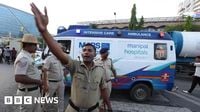On June 4, 2025, a joyous occasion turned tragic outside the M. Chinnaswamy Stadium in Bengaluru, southern India, when a massive crowd of cricket fans celebrating the Royal Challengers Bengaluru's (RCB) first Indian Premier League (IPL) title win became the scene of a deadly stampede. At least 11 people lost their lives, and more than 30 were injured in the chaos that unfolded as tens of thousands of supporters thronged the stadium area in an attempt to join the celebrations.
The stampede occurred during a special felicitation event organized by the Karnataka State Cricket Association (KSCA) to honor the RCB team’s historic victory over the Punjab Kings in the IPL final on June 3, 2025. Fans had gathered in overwhelming numbers—far beyond expectations—with estimates ranging from 200,000 to 300,000 people, while the stadium itself only holds about 35,000 spectators. This enormous turnout, as Karnataka Chief Minister Siddaramaiah noted, was something authorities had not anticipated.
“No one expected such a huge crowd,” Siddaramaiah said solemnly, confirming that 11 people had died and 33 others were injured, most of whom were stable and receiving treatment at local hospitals. The crush happened as the crowd attempted to break through one of the stadium’s gates, which had not even been opened yet, leading to a deadly surge of people desperate to get inside and celebrate. “A moment of joy has been eclipsed by sorrow,” the Chief Minister added, expressing his deep shock over the tragic loss.
Deputy Chief Minister D.K. Shivakumar described the crowd as “very uncontrollable,” highlighting the difficulty police faced in managing the overwhelming numbers. Despite a large police presence, the situation escalated quickly as fans surged toward the gates from multiple directions. Police resorted to mild force, including lathi charge, in an effort to control the crowd, but this only added to the chaos. Visuals from the scene showed people fainting, being trampled, and emergency personnel rushing the injured and unconscious into ambulances.
One particularly harrowing incident involved a fan who, in an attempt to climb over a stadium gate to gain entry, fell and broke his leg. Others were seen climbing trees and hanging from branches just to catch a glimpse of their heroes. The stampede's aftermath saw ambulances struggling to reach Bowring Hospital due to the overcrowded roads, further complicating emergency response efforts.
The Royal Challengers Bengaluru team had earlier distributed free passes for the event via their website and urged fans to follow police guidelines. In a statement, the team expressed that they were “deeply anguished” by the tragedy that marred what should have been a festive occasion. Cricket legend Virat Kohli, present at the brief reception inside the stadium despite the chaos, spoke to the crowd, though the mood was understandably somber.
The Board of Control for Cricket in India (BCCI), the governing body organizing the IPL, called the incident “unfortunate.” BCCI secretary Devajit Saikia remarked, “This is a negative side of popularity. People are crazy for their cricketers. The organizers should have planned it better.” This pointed criticism underscores the challenges of managing such massive public events, especially when emotions run high and crowds swell unpredictably.
Indian Prime Minister Narendra Modi described the incident as “heartrending,” extending his thoughts to all those who lost loved ones in the tragedy. This latest stampede is sadly not an isolated event in India, where large gatherings have frequently resulted in deadly crushes. Earlier in January 2025, at least 30 people died during the Maha Kumbh festival, the world's largest religious gathering, when tens of thousands rushed to bathe in a sacred river.
Authorities had anticipated large crowds for the IPL celebrations and had even canceled an open bus victory parade from Vidhana Soudha to the stadium due to security concerns, a decision that now appears prescient. However, despite these precautions, the sheer volume of people converging on the stadium overwhelmed existing safety measures.
Public transport was also heavily affected. Metro trains were packed to capacity, with many fans unable to board, while auto rickshaws and taxis were largely unresponsive or dropped passengers several kilometers away from the stadium, forcing more people to travel on foot through congested streets. After the stampede, metro stations around the stadium were shut down to prevent further crowding.
Eyewitness accounts describe a scene of pandemonium, with fans chanting the team’s name in unison while pushing against barriers and each other in a desperate attempt to be part of the historic moment. The tragedy has cast a long shadow over what should have been a day of celebration for Bengaluru and cricket lovers across the country.
As investigations continue, questions are being raised about crowd management, emergency preparedness, and the responsibilities of event organizers and local authorities. The incident serves as a stark reminder of the dangers inherent in mass gatherings and the critical need for meticulous planning and coordination to ensure public safety.
For now, the city mourns the loss of life and tends to the injured, while the cricket community grapples with the bittersweet reality of a victory marred by sorrow. The Royal Challengers Bengaluru’s historic IPL win will be remembered, but so too will the tragic events that unfolded in its wake.


